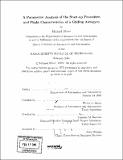| dc.contributor.advisor | Wesley L. Harris and Timothy M. Barrows. | en_US |
| dc.contributor.author | Oliver, Michael, 1981- | en_US |
| dc.contributor.other | Massachusetts Institute of Technology. Dept. of Aeronautics and Astronautics. | en_US |
| dc.date.accessioned | 2005-09-27T19:01:04Z | |
| dc.date.available | 2005-09-27T19:01:04Z | |
| dc.date.copyright | 2005 | en_US |
| dc.date.issued | 2005 | en_US |
| dc.identifier.uri | http://hdl.handle.net/1721.1/28910 | |
| dc.description | Thesis (S.M.)--Massachusetts Institute of Technology, Dept. of Aeronautics and Astronautics, 2005. | en_US |
| dc.description | "CSDL-T-1503, digital appendix"--CDROM label. Appendix B of thesis text contains an index to the CDROM. | en_US |
| dc.description | Includes bibliographical references (p. 113-114). | en_US |
| dc.description.abstract | Currently, Draper Laboratory is in the development stages of a gliding autogyro airdrop system. The goal of the project is to design a platform capable of placing small, high value items into urban terrain. Theoretically, autogyros can achieve descent rates and glide slopes similar to current parafoil based systems, but do so with greater precision. Over the past half-century most rotorcraft research has focused on helicopter design, only viewing autorotation as a means of achieving emergency landings. In contrast, this project utilized early rotor theory to develop algorithms which can predict unpowered rotor performance across the entire flight envelope. To validate these predictions, a vertical wind tunnel capable of testing rotors up to 4 feet in diameter at descent rates of up to 25 ft/s was constructed. Emphasis was also placed on developing deployment sequences that would allow the system to achieve stable autorotation autonomously. By varying parameters such as blade pitch angle and rotor solidity, it is shown that in the proper configuration, rotor based systems can match and even surpass parafoils in areas such as descent rate and glide slope. The autogyro also has the added capability of varying its lift-to-drag ratio in flight while maintaining reasonable descent speeds, allowing for more precise control to the target. Possible deployment sequences are displayed, proving that relatively simple configurations can be brought into stable autorotation. The algorithms developed and vertical wind tunnel constructed for this project can be used to gain further knowledge of autogyro performance. | en_US |
| dc.description.statementofresponsibility | by Michael Oliver. | en_US |
| dc.format.extent | 114 p. | en_US |
| dc.format.extent | 4876593 bytes | |
| dc.format.extent | 4890451 bytes | |
| dc.format.mimetype | application/pdf | |
| dc.format.mimetype | application/pdf | |
| dc.language.iso | en_US | |
| dc.publisher | Massachusetts Institute of Technology | en_US |
| dc.relation.requires | CDROM contains files in .xls, .m (MATLAB), and .wmv formats. | en_US |
| dc.rights | M.I.T. theses are protected by copyright. They may be viewed from this source for any purpose, but reproduction or distribution in any format is prohibited without written permission. See provided URL for inquiries about permission. | en_US |
| dc.rights.uri | http://dspace.mit.edu/handle/1721.1/7582 | |
| dc.subject | Aeronautics and Astronautics. | en_US |
| dc.title | A parametric analysis of the start-up procedure and flight characteristics of a gliding autogyro | en_US |
| dc.type | Thesis | en_US |
| dc.description.degree | S.M. | en_US |
| dc.contributor.department | Massachusetts Institute of Technology. Department of Aeronautics and Astronautics | |
| dc.identifier.oclc | 60495046 | en_US |
